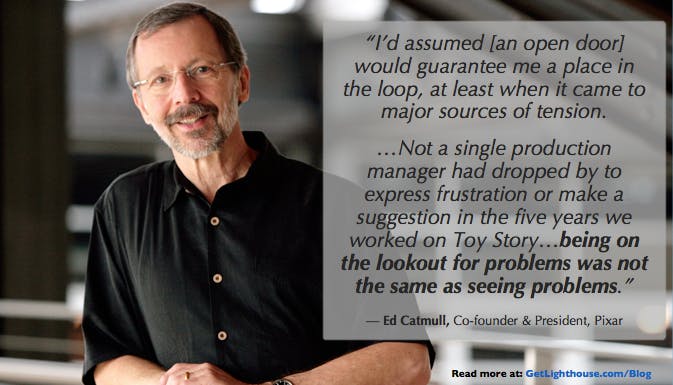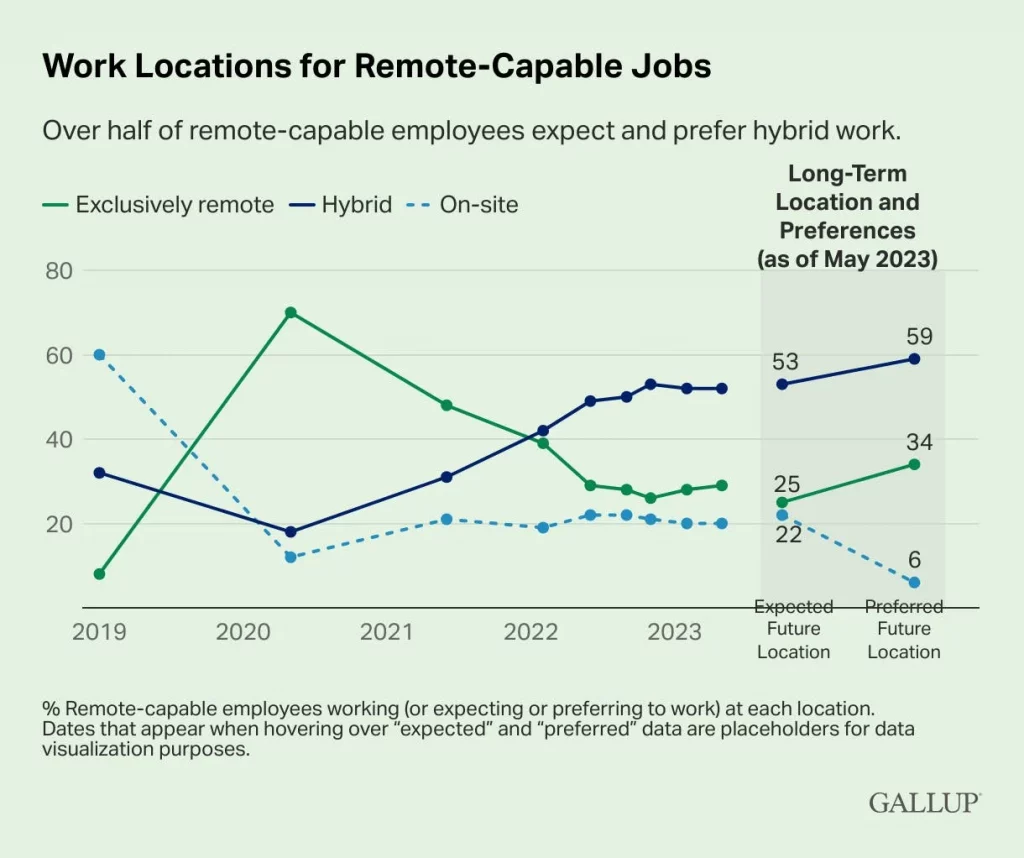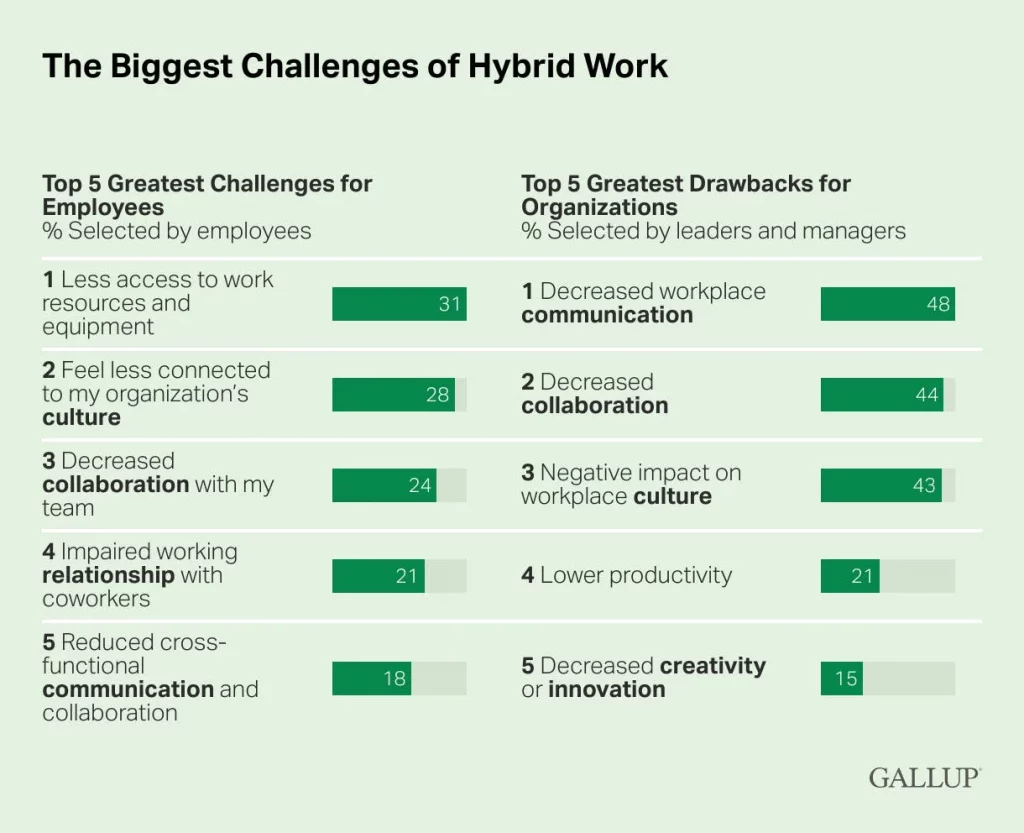In today’s edition, we cover the death of the inventor of MBWA, more data on hybrid work, one of my favorite lessons from the Book of the Month, and our long read covers the lessons for managers of a leadership classic.
Let’s dive in…
Table of contents:
- 🥘 Food for Thought on MBWA no matter where you are
- 📰 News & Reports for Managers on Making Hybrid Work for Everyone
- 📚 Book of the Month on my Favorite Lesson from The Score Takes Care of Itself
Note: This is a preview of our weekly leadership newsletter, Lighthouse Leadership Weekly (LLW).
To get this sent to your inbox every week, along with our latest long form essays on this blog, you can sign up here.
🥘 Food for Thought
"We need less of the MBA perspective, and more MBWA, management by wandering around, action." - Bob Sutton, Organizational psychologist at Stanford and best selling author on leadership and management.
I saw this tweet this week and knew we needed to talk about it:
RIP John Doyle. @HP exec who coined "MBWA. "
— Bob Sutton (@work_matters) February 11, 2024
He wrote me in 2019 that, after watching Bill and Dave in the 1960s, he urged colleagues:
"We need less of the MBA perspective, and more MBWA, management by wandering around, action." https://t.co/RVjbf7jtgy
What is (MBWA) Management By Walking Around?
It helps to start by getting everyone on the same page, and this is a term I think many of you aren't that familiar with. It was a much bigger deal in my father's generation than today.
This post on Linkedin gives a good overview, which includes this definition:
"MBWA is essentially a management style in which the manager walks around the workshop or office in unstructured and unscheduled manner, spending time listening to problems and ideas of their staff."
The point is that rather than sitting in an office and waiting for people to proactively come to you, you go out and see what you can find by interacting with others on your team.
This is about listening and being friendly, not an inquisition.
The mindset you have when you MBWA is as important as getting up and moving around. Your goal is to be friendly, approachable, and see what happens.
If you're in the office, that means saying hello and seeing who makes eye contact with you when you walk around, not interrupting everyone who looks intently focused or grilling people.
What you'll find is that if people have something to say or ask, they'll approach you, or engage with you when you walk past them. Then, as you engage one person, you may be surprised that as you wrap up with them, someone else may engage as well.
The point of doing this is well captured by Ed Catmull, co-founder of Pixar:

Over time, you'll find even a little time spent walking around like this can help you understand how your team is doing, troubleshoot problems while they're easy to fix, and give you a much better pulse on what's happening with your team. They also may change how they feel about you, because your helpfulness and approach-ability feels very different from being the cold, distant person in the office.
What about remote and hybrid teams?
Now, you may be thinking, "What do I do if my team and I aren't all in the same office space together?"
That's a great question.
You're right that does make literally "walking around" difficult or impossible.
You can't really simulate the serendipity of walking by someone's desk with just about any tactic you'd do remotely. However, that doesn't mean you shouldn't try.
Here's a few things you can do:
- Have more frequent 1 on 1s: If you can't get a pulse by walking around, you must seek out opportunities to connect with your team. Your 1 on 1s are one of the best ways to do that, so if you're remote, you should have them more often than you may be used to with an in-office team.
- Make time for Peer and Skip Level 1 on 1s: You'll often want to connect with more than just your direct reports. Having Skip Level 1 on 1s and Peer 1 on 1s are great ways to build connections and uncover issues before they blow up beyond just your direct reports.
- Look for opportunities for small talk at the start of meetings: It can take a few minutes for meetings to start with a group. If you arrive early, use it as a chance to chat with whomever is there. Ask about a key project, how their work is going, what's on their mind. You may not solve anything there, but it will give you a hint to follow up after.
- Make your availability clear to your team: Open door policies do NOT work. Sorry to say, but it's true. That said, you can help a bit by making your away/present status clear in your company's chat. Then people know when they can ping you for a quick question. I like the app Clockwise to automatically change my status based on my calendar schedule.
- Be pro-active about looping in others: One of the big challenges of remote work is that it's not as natural to loop in others. While you can walk past a desk and grab everyone you need, it's easy to accidentally only talk to the person who DM'd you in chat or called you. To get more info and context, it's important for you to proactively think about who to loop in, too.
These are all partial solutions, with nothing being quite like walking around your office with your team.
If you have ideas on how else to do MBWA while remote, reply and share your tips!
📰 News & Reports for Managers
📌 Gallup shares the keys to surviving Hybrid work
We've looked at a lot of data over the last year or so about the rise of hybrid work. It's now the most common way we all work, and is expected to be that way for a long time:

There's a few things to notice from this chart:
- On-site offices aren't coming back: 2021-2023 have seen a steady rate of office work locations of around 20%. If you love office work, you can still find places like that, but it's now the minority, instead of the pre-COVID majority.
- No one likes offices anymore: It's pretty stunning to see that only 6% of workers prefer offices going forward. I wonder how much of that is due to seeing everyone else having remote and hybrid options?
- Hybrid continues to dominate: There has been a steady climb since COVID of hybrid work setups. You can also see that it's the preferred future location for nearly 60% of all surveyed workers. Managers like you must prepare your skills accordingly.
Knowing point #3, it's helpful that Gallup has paired this data with a breakdown of the challenges that are coming with our hybrid-dominated workplaces:

As you can see, managers and team members tend to agree on a few major issues:
- Culture: It's harder to feel connected to a common mission and work community when you're physically spread apart. Retreats, and other intentional rituals can help.
- Collaboration: It's a lot easier to collaborate when you can turn to the other person to get their help or include them. As a leader, you need to be proactive to create more collaboration.
- Communication: As we just discussed last section, communication is another obvious remote hurdle. A multi-prong approach is required to address it.
Remote leadership has a lot of surprising hurdles you may not have been ready for. We have a post dedicated to these surprises and what you can do about them here.
📚 Book of the Month on my Favorite Lesson from The Score Takes Care of Itself
Grown men running full speed into each other at high speeds. Grunts, groans, and sweat.
These are the things that often come to mind with football.
Yet, my favorite lesson from legendary NFL coach, Bill Walsh, is 4 surprisingly powerful and unexpected words: "I believe in you."
Walsh put it best in his own words:
"You need to stretch people to help them achieve their full potential...the most powerful way to do this is by having the courage to say, "I believe in you."
These four words constitute the most inspirational message a leader can convey."
Whether you’re young or old, we all have dreams and aspirations. If you can help someone uncover those goals, then encourage them, and tell them you believe they can do it, you will truly inspire them. As a manager, believing in who your people can become is the most powerful thing you can do.
There are people that see you for who you are, who you were, and who you can be.
— Jason Evanish (@Evanish) April 5, 2014
Focus on the latter.
Walsh took that responsibility and opportunity, very seriously. He developed 6 future Hall of Famers, and coached 4 Super Bowl winning teams.
And through all of that, showing belief in his team members, and helping them grow was his favorite part of his job:
"One of the things I love most about leadership - teaching a person how to reach high and higher, to achieve great things with his or her talent."
When was the last time you told someone on your team you believed in them?
Try it this week, and you may be surprised how positively they respond.
More on belief + Bill Walsh:
- You can read an in depth post on the importance and power of belief here.
- See 5 of our favorite takeaways from Bill Walsh's book here.
- And if you haven't yet, get your copy of Bill Walsh's The Score Takes Care of Itself here.
Sign up to get this newsletter & our latest blog posts straight to your inbox:




